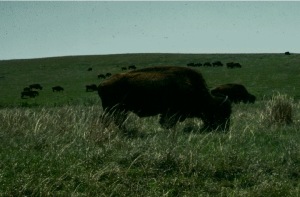Putting the Piece of the Prairie Back Together in Illinois – Bison in the Nachusa Grassland

by Roger Anderson
In Sand County Almanac, Aldo Leopold described the occurrence of a single compass plant in a graveyard that was established in the 1840’s. Each year in July, the plant produced a single flowering stalk with “…yellow saucer-sized blooms resembling sunflowers.” He speculated that this plant might be the single remnant of the species in the western half of the county. Leopold lamented that, “What a thousand acres of Silphiums looked like when they tickled the bellies of the buffalo is a question never again to be answered, and perhaps not even asked.” In Illinois, we still have sites with compass plants, but wild buffalo were likely exterminated in Illinois by 1808. Bison are considered to be a keystone species in prairies. Their diet consists mostly (90-95%) of prairie grasses, which can suppress the growth and diversity of prairie wildflowers (forbs), especially when the prairies are frequently burned. By grazing on grasses and reducing their competitiveness, bison can increase the species richness and diversity of prairie plants that is due largely to the forbs.
The historic bison herds in Illinois were small (a few 100 animals) compared to herds in the Great Plains that could number of tens thousands. This spring, 30 bison were reintroduced into The Nature Conservancy’s Nachusa Grassland near Dixon, Illinois, which is 95 miles west of Chicago. The introduced animals are unique in that they are “pure bison” and do not carry genes from cattle, as do most bison in parks, wildlife refuges, and ranches that raise bison for human food. The bison herd now occupies a prairie of 500 acres, but bison will eventually occupy much of the 3,500-acre Nachusa Grasslands. The birth of 18 bison calves this spring and calves born in the future will play a key role in this ambitious prairie restoration.

For more information on the bison in the Nuachusa Grassland, check out The Nature Conservancy’s page or the Friends of Nachusa Grasslands page.

